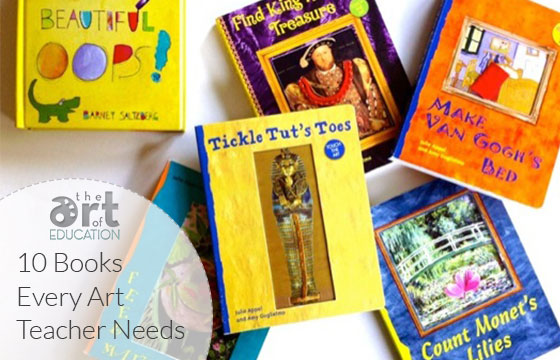
In today’s schools, there’s always a push for literacy integration, and I find stories to be amazing teaching tools in the art room. I use picture books to supplement my lessons, introduce art history in kid-friendly ways, and begin discussions about creativity, defining art, art concepts, or art careers. A story is going to stick with students longer than a list of facts, because it’s easier to remember and appeals to them on a positive, emotional level. Below is a list of books that can be appreciated and embraced for their enduring messages, creative inspiration, encouragement to be a unique, confident artist, and inspiration for numerous projects
Beautiful Oops by Barney Saltzberg
I LOVE this book, and so do my students. It encourages young artists to embrace their mistakes and make them into something beautiful…a “beautiful oops”. This is a great message for all ages. Throughout the year, many catastrophes were avoided as my students acknowledged their mistakes as beautiful oops’. This book also has the hidden moral gem that teaches the valuable lesson of adapting and using critical thinking skills to endure and achieve success.
The Dot and Ish by Peter H. Reynolds
Okay, I cheated by naming two, but no art room (or art teacher) is complete without these two stories. Both stories are about young artists learning to express themselves and overcoming hurdles in the creative process. The Dot’s simple phrase, “Make a mark, and see where it takes you” stuck with my kiddos throughout the year. More cheating: also check out The Museum by Susan Verde, Illustrated by Peter H. Reynolds.
Press Here by Herve Tullet
A very cute ‘interactive’ book that’s a real crowd pleaser! I encourage you to read it through yourself first, so you know the actions you have to take as the narrator in order to “move” the dots in the book. It’s also a fun book to pair with a primary colors lesson. Herve Tullet just came out with another book, I am Blop!
Not a Box by Antoinette Portis (and also Not a Stick)
Your essential guide to warming up creative thinking skills, brainstorming, and introducing a lesson requiring imagination and innovation. Not a Box follows a cute bunny through his imaginary adventures with a cardboard box: It’s a rocket ship, it’s a fire truck, it’s a robot, etc. Not a Stick further encourages its audience to “think outside the box”, developing different uses for shapes, forms, and objects. I usually pair this with my Not a CD lesson that requires my students to transform this circular shape into another object. (Not a [Popsicle] Stick works just as well!)
A Day with No Crayons by Elizabeth Rusch
A book about creating all kinds of art without crayons! A great introduction to a found object project, or discussing all the different materials and tools that can be used to make art.
The Day the Crayons Quit by Drew Daywalt
The crayons have had it! They’re sick of being used for the same old things: yellow for the sun, green for the grass, gray for an elephant. Great for conversation about color association, and inspiration to use color in unusual ways. This would also be a perfect sub lesson: no hassle materials, and the only guideline is that you have to use color in a new way!
Lines that Wiggle by Candace Whitman
A glittery, rhyming introduction to line. After we read this book, we try to find all the different kinds of lines we can remember reading about. My only wish is that they had a book like this for all the elements of art!
My Many Colored Days by Dr. Seuss
The old classic! Another great conversation starter about color association, this time with emotion. There is also a wonderful video that features this animated story with symphony music.
Perfect Square by Michael Hall
Transforming a perfect square of paper into a multitude of things by tearing, cutting, crumpling, and arranging. Another book about exercising “thinking outside the box” skills! Also, another great option as a sub lesson.
The Touch the Art Series by Julie Appel and Amy Guglielmo
If I could order multiples of books, this series would be it. Some titles include Pop Warhol’s Top, Brush Mona Lisa’s Hair,and Feed Matisse’s Fish. My kiddos ADORE these books, and the best part is that they’re interacting with art history and masterpieces! Each page of these board books has some sort of textured, movable, or 3-D piece that can be manipulated. These are always the first books nabbed and shared, with three to four kiddos crowding around one book. I especially love these books because of their wide appeal and benefits to ALL my different students!
Have you used any of these books in your classroom?
What other books would you add to the list?
Magazine articles and podcasts are opinions of professional education contributors and do not necessarily represent the position of the Art of Education University (AOEU) or its academic offerings. Contributors use terms in the way they are most often talked about in the scope of their educational experiences.




